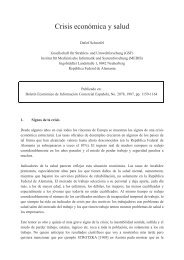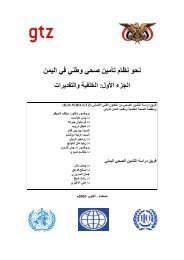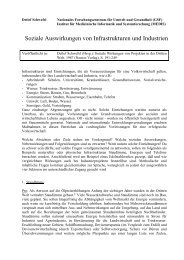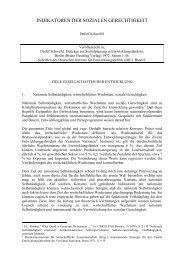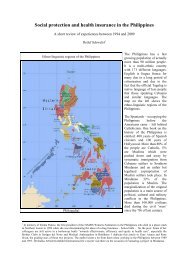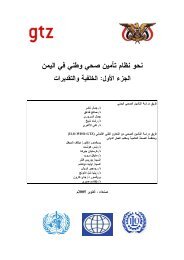Towards a national health insurance system in ... - Detlef Schwefel
Towards a national health insurance system in ... - Detlef Schwefel
Towards a national health insurance system in ... - Detlef Schwefel
You also want an ePaper? Increase the reach of your titles
YUMPU automatically turns print PDFs into web optimized ePapers that Google loves.
<strong>Towards</strong> a <strong>national</strong> <strong>health</strong> <strong><strong>in</strong>surance</strong> <strong>system</strong> <strong>in</strong> Yemen – Part 1: Background and assessments 23<br />
early as possible. A recent field study supported by Oxfam revealed that child marriage is mostly<br />
present <strong>in</strong> the Governorates of Hadramaut and Hudeida. It confirmed that girls who marry at young<br />
age leads to far too early pregnancy, and lose opportunities of education and acquisition of skills that<br />
would allow them to get a suitable <strong>in</strong>come (Yemen Times, 22 nd Sept. 2005).<br />
Another characteristic element of the Yemeni society is the low participation of women on society<br />
level. This becomes evident for <strong>in</strong>stance compar<strong>in</strong>g the accident statistics of the country’s largest<br />
specialised hospital Al-Thawra <strong>in</strong> Sana’a: Only 3 out of 100 victims of traffic accidents <strong>in</strong> 2004 were<br />
female, while more than 13 % were children. Regard<strong>in</strong>g formal sector employment, <strong>national</strong> female<br />
staff occupies less than one out of 26 work places owned by Yemeni citizens <strong>in</strong> private companies. 9<br />
On the other hand, ma<strong>in</strong>ly <strong>in</strong> rural areas women are often exposed to the double burden of family<br />
management and <strong>in</strong>come generation through work <strong>in</strong> the field. Although the Constitution of the<br />
Republic of Yemen declares equal rights between men and women, the latter do not have the equal<br />
chances to participate <strong>in</strong> public life. In general, women are not taken a serious as men, and <strong>in</strong> public<br />
meet<strong>in</strong>gs male representatives tend to laugh about female speakers. With regard to <strong>health</strong> care and<br />
<strong>health</strong> <strong><strong>in</strong>surance</strong> it will be important to stress social constra<strong>in</strong>ts <strong>in</strong> traditional areas. In many cases,<br />
access to needed care for women is restricted because they need male escorts for apply<strong>in</strong>g to <strong>health</strong><br />
facilities, and they have to be seen by female <strong>health</strong> workers, who are not readily available at <strong>health</strong><br />
facilities <strong>in</strong> most of the country.<br />
Another important asset of the socio-cultural sett<strong>in</strong>g <strong>in</strong> Yemen seems to be relevant for the<br />
implementation and perspective of a <strong>national</strong> <strong>health</strong> <strong><strong>in</strong>surance</strong> <strong>system</strong>. As mentioned above, tribal<br />
structures and hierarchies are still <strong>in</strong> place all over the country, ma<strong>in</strong>ly <strong>in</strong> the highlands and <strong>in</strong> Eastern<br />
governorates. Nation-build<strong>in</strong>g is an ongo<strong>in</strong>g process, and social identity refers rather to community<br />
and tribal sett<strong>in</strong>gs than to the Yemeni state. This is reflected <strong>in</strong> the existence of numerous small scale<br />
solidarity schemes while a perspective of overall society solidarity is still miss<strong>in</strong>g or underdeveloped<br />
<strong>in</strong> most citizens. In addition, the persist<strong>in</strong>g impact of tribal structures on society can expla<strong>in</strong> the<br />
relevance of paternalistic patterns <strong>in</strong> social groups and <strong>in</strong>dividuals. For <strong>in</strong>stance, company-driven<br />
<strong>health</strong> benefit schemes rely to a certa<strong>in</strong> extent on case-to-case decisions of the lead<strong>in</strong>g personnel. And<br />
the population shows a high expectation to receive support from others, let it be a charitable<br />
organisation, the M<strong>in</strong>istry of Health who is expected to grant a series of services for free, or an<br />
<strong>in</strong>ter<strong>national</strong> donor or development agency. When it comes to start <strong>in</strong>itiatives and to assume<br />
responsibility, many <strong>in</strong>terviewees hesitate or withdraw and express the expectation that the<br />
Government or any other “leader” makes the first steps.<br />
3.1.3 Socio-economics 10<br />
Population growth is still high <strong>in</strong> Yemen. The most recent official figures h<strong>in</strong>t at 3.02% (RoY-MoPIC<br />
2005), close to what <strong>in</strong> an <strong>in</strong>dependent <strong>health</strong> survey was measured with 3.1%. (Soeters 2004)<br />
Urbanisation <strong>in</strong> Yemen is estimated at about 5% and is grow<strong>in</strong>g at almost double the population<br />
growth rate. (NN 2005) Close to 9% of the population live <strong>in</strong> the largest city, Sana’a. About three<br />
quarters of the population lives outside urbanised areas and 80% of the rural population live <strong>in</strong><br />
scattered settlements with less than 500 people (RoY 2004b). The average household size is estimated<br />
at 8.14 household members (UNICEF 2003, p. 12). Surveys show that the poorest households average<br />
9.8 people (Soeters 2004, p. 13). Accord<strong>in</strong>g to another survey, the average family size <strong>in</strong> Yemen is<br />
7.0; while 40 % of households have more than 7 members, 26.5 % have 1-4 and the rema<strong>in</strong><strong>in</strong>g 32.9 of<br />
Yemeni households 5-7 <strong>in</strong>dividuals (PAPFAM 2004, p. 12). 11<br />
9 26,089 women amongst 685,402 salaried persons. Source: Results of Labour Force Demand Survey <strong>in</strong> Private<br />
Establishments 2003<br />
10 In the follow<strong>in</strong>g only those basic features will be mentioned that have an impact on <strong>health</strong> seek<strong>in</strong>g behaviour and on <strong>health</strong><br />
services delivery and f<strong>in</strong>anc<strong>in</strong>g.<br />
11 All demographic figures appear to be doubtful <strong>in</strong> the Yemeni country context; please note that not more than 10.8% of<br />
children under 5 have a birth certificate (range 0.7 - 46.4%), and <strong>in</strong> the capital of Sana’a this proportion is only 6.9 %!<br />
(UNICEF 2003, p. 12).





